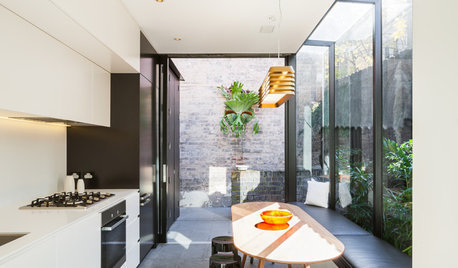Which one is good enough?
udo69
14 years ago
Related Stories

KITCHEN COUNTERTOPSWhen One Countertop Material Isn’t Enough
Combining counter materials in the kitchen can create a dramatic look, improve function and stretch the budget
Full Story
CONTEMPORARY HOMESHouzz Tour: Strong Enough for Storms, Comfy Enough for a Family
Hurricanes won’t faze this contemporary waterfront home in North Carolina — and mixed reactions don’t faze its owner
Full Story
KITCHEN DESIGN12 Great Kitchen Styles — Which One’s for You?
Sometimes you can be surprised by the kitchen style that really calls to you. The proof is in the pictures
Full Story
FURNITUREWhich Dining Table Shape Should You Choose?
Rectangular, oval, round or square: Here are ways to choose your dining table shape (or make the most of the one you already have)
Full Story
KITCHEN SINKSWhich Faucet Goes With a Farmhouse Sink?
A variety of faucet styles work with the classic farmhouse sink. Here’s how to find the right one for your kitchen
Full Story
KITCHEN DESIGNTrending Now: 25 Kitchen Photos Houzzers Can’t Get Enough Of
Use the kitchens that have been added to the most ideabooks in the last few months to inspire your dream project
Full Story
ARCHITECTUREHouzz Tour: Sturdy Enough for a Tsunami
Storms don't scare this Washington state home; breakaway features and waterproof finishes let it weather high winds and waves
Full Story
HOLIDAYSHow to Have a Just-Simple-Enough Holiday
Make this the year you say no to holiday stress and yes to joy and meaning
Full Story
HOME TECHIf ‘High-Def’ TV Isn’t High Enough, Maybe You Need Ultra-HD
The ultra-luxury next generation of TV, called Ultra-HD, is finally here. And so is the first content, if you know where to look
Full Story
ORGANIZINGHow Much Stuff Is Enough?
Play the numbers game to streamline your belongings, for a neater home and a less-stressed you
Full StoryMore Discussions






bromadams
mike4284m
Related Professionals
Tempe Landscape Architects & Landscape Designers · Rancho Cordova Landscape Architects & Landscape Designers · River Forest Landscape Architects & Landscape Designers · Aurora Landscape Contractors · Bridgeview Landscape Contractors · Cicero Landscape Contractors · Mahwah Landscape Contractors · Mercedes Landscape Contractors · San Antonio Landscape Contractors · Clermont Fence Contractors · Clarksburg Fence Contractors · Gardena Fence Contractors · League City Fence Contractors · Fountain Valley Fence Contractors · Oregon City Siding & Exteriorsavane_gw
hotdiggetydam
LisaCLV
splinter1804
vriesea
lyndi_whye
hanwc
bromadams
kerry_t_australia
paul_t23
udo69Original Author
sunshine_qld
LisaCLV
avane_gw
jaga
devo_2006
fdnpedro
udo69Original Author
sunshine_qld
LisaCLV
avane_gw
fdnpedro
udo69Original Author
vriesea
malleeaustralia
udo69Original Author
vriesea
udo69Original Author
avane_gw
LisaCLV
udo69Original Author
hotdiggetydam
LisaCLV